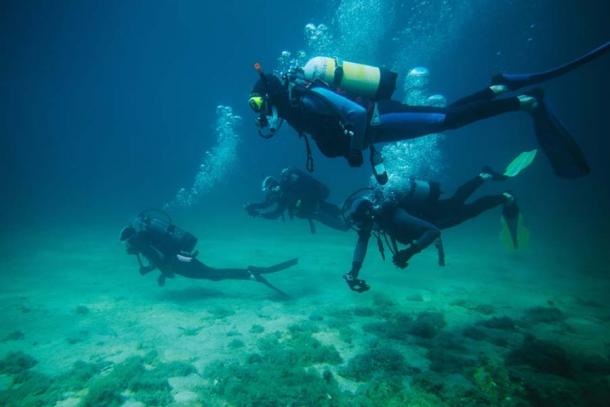World’s Oldest Pearl Found in Abu Dhabi is 8,000-Years-Old!
Archaeologists in Abu Dhabi have found an 8,000-year-old pearl - the world’s most ancient specimen.
According to Emirati archaeologists the exquisite natural pearl is proof that valuable objects have been traded since Neolithic times. The pearl was dug up during excavations at Marawah Island, off the capital of the United Arab Emirates, and it will be displayed for first time publicly in the exhibition 10,000 Years of Luxury, opening on October 30th at the Louvre Abu Dhabi.
The Marawah site is one of the oldest sites in the country and is made up of numerous collapsed Neolithic stone structures which have yielded ceramics, beads made from shell, and stone and flint arrowheads. But Mohamed al-Muabarak, the chairman of Abu Dhabi’s department of culture and tourism, told the press that the layers from which the pearl came have been carbon dated to “5,800 – 5,600 BC,” which is why it is being hailed the oldest pearl in the world.

Marawah site, where the pearl was discovered. (Archaeology.org)
Pearls In The Ancient World
With the world’s most ancient pearl dating to 5,600 BC Pearl-Guide.com will need updating, for at the moment it says pearls have been prized and collected “for more than 4,000 years”. In ancient Egypt, mother-of-pearl was used for decorative purposes as far back as 4,000 BC and Chinese records determine they were prized possessions and gifts of royalty, and in India ancient Hindu texts refer to the god Krishna discovering the first pearl.
- Fingerprints of Ancient Masons Reveal Advanced Iron Age Construction Technique
- Curse of the Buried Pearl: Ancient Magick and the Many Hazards of Treasure Hunting – Part II
- Who Were the Mysterious Neolithic People That Enabled the Rise of Ancient Egypt?

Hindu mythology says the god Krishna discovered the first pearl. (Virumandi1 / CC BY-SA 4.0)
According to Khanacademy the ancient Sumerian civilization formed in southern Mesopotamia (modern Iraq) around 4,000 BC and had developed the first written scripts around 3,000 BC including The Epic of Gilgamesh. Ancient Sumerians are known to have sailed in the Persian Gulf where they traded goods with the Harappans in northern India including textiles, leather goods, and jewelry in return for Harappan copper and semi-precious stones including ivory and pearls.

Ancient Sumerians traded in luxury goods such as jewelry and pearls in Mesopotamia. (पाटलिपुत्र / Public Domain)
Ancient Freediving For Treasures
In Peter Roger and Stuart Moorey’s 1999 book Ancient Mesopotamian Materials and Industries: The Archaeological Evidence we are told that a small string of pearls from the late prehistoric horizon remained an “isolated find” and that these pearls are suspected to have been obtained from Oman. However, Emirati archaeological experts at the culture department pointed out that the Venetian jewel merchant Gasparo Balbi, who traveled through the region in the 16th century, mentioned the islands off the coast of Abu Dhabi as a “source of pearls”.
The remaining question is where and how on earth did ancient people find and collect pearls? According to a report of FreeDivingUAE people were actively engaged in the search for pearls in Mesopotamia “in 4,500 BC” after archaeologists found decorative objects with pearls which they say could “only be obtained from the seabed” confirming that there were professional pearl divers a very, very long time ago.
While we will never know exactly when people began to dive deep for pearls most likely people started freediving in order to catch food and then, learning that some shells have pearls, freediving became a way to obtain unique treasures that couldn’t be found on the shores and beaches.
The Perils Of Collecting Pearls
Pearl divers have always been faced with a list of life endangering variables including the very real threat of shark attacks as well as the crippling effects of the dreaded “bends” which can strike at any time. Goodness knows what it must have been like in prehistoric times but in the late 19th century and early 20th century, pearl divers mortality rates was as high as 50% and today there are strict protocols and regulations regarding occupational pearl diving to reduce these risks.

Pearl divers face great risks. (yossarian6 / Adobe Stock)
While the pearl about to go on display at the Louvre Abu Dhabi is the world’s oldest, it has some growing to do to rival the size and esteem of what is known as the world’s most famous pearl. A National Geographic article discussing “La Peregrina” (Spanish for ‘the incomparable’) features a 500 year-old pear shaped pearl which is the size of “a large pigeon’s egg” which was previously owned by a king of Spain, Napoleon Bonaparte, and the actress Elizabeth Taylor and is valued at over $100 million dollars.
Top image: The world’s oldest pearl has been discovered at Marawah Island, United Arab Emirates. Source: Arundhati Chaudhuri / CC BY-SA 2.0.
By Ashley Cowie


















Comments
An 8000 year old pearl, from a part of the world where the domestication of animals didn’t happen until 7000 years ago. So this is truly a case of pearls before swine.